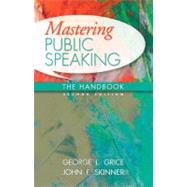An adaptation of Mastering Public Speaking 6e, this handbook provides the reader with a 2-color, less costly alternative to the 4-color book in a reference format, enabling quick and easy access to information. This book equips the reader with a firm grounding in the “hows” and “whys” of public speaking by providing an ideal balance of theory and skills while placing important emphasis on critiquing, ethics, and critical thinking.
By eliminating those activities not essential to learning the basics of public speaking, readers are then able to learn how to think critically as they choose speech topics, conduct research, organize content, select language, manage nervousness, and deliver speeches. Additionally, the tabbed sections include a quick overview to the chapters within the section.
The new edition of Mastering Public Speaking: The Handbook places greater emphasis on the practical application of theory and concepts. Following suggestions from reviewers and editors, the authors have updated examples, websites, and references to technology. With subtle deletions in theory sections, changes in language, and a greater humber of bulleted lists of suggestions and strategies, the authors have provided a stronger focus on application to help students become more effective speakers.








